


|
 |
|
|
#1 |
|
Registered Member
Join Date: May 2012
Posts: 100
|
Gorgeous... but what should I do?
(Can't find an ID section for this to go in), hope you can help.
So noticed this on the pussey coral about a month ago, looked just like new growth. I returned home today and noticed it had moved. It was never on the coral, but around its base. As it had moved I thought it best to remove before it were to disappear. I found out the scientific name of the pussey, which is Alcyonium sp. and a little bit of research showed the nudibranch: Tritonia hombergii A google image search showed a few results of similar looking. The diet was said to be Alcyonium digitatum. Which is of the same genus. Now on research it I found a few thing summarised by this: Phylum Mollusca Snails, slugs, mussels, cockles, clams & squid Class Gastropoda Snails, slugs & sea butterflies Authority Cuvier, 1803 Recent synonyms Tritonia hombergii Recorded Distribution in Britain and Ireland Occurs all around the Britain and Ireland. Habitat information Tritonia hombergi can be found down to depths of 80 m and is always associated with the soft coral Alcyonium digitatum. Description Tritonia hombergi is the largest British nudibranch growing up to 20 cm in length. The body varies in colour from white to a dark purple brown and is lighter ventrally (colour darkens with age). The rhinophores are branched at the tip with basal sheaths. The mantle is covered with numerous soft tubercles, which release an irritant compound. On the sides of the upper surface there are noticeable gills, of varying size. The larger gills orientate towards the centre of the body while smaller gills flex out to the side. The total number of individual gills increases significantly with age. The front section of the head (the oral veil) is divided into two lobes and, characteristically for members of the genus Tritonia, each lobe is divided into numerous finger-like projections. Identifying features Body colour white to dark purple Rhinophores branched at the tips and have basal sheaths. Surface covered in numerous tubercles Gills of vary size, large gills point towards centre of body, small gills point outwards. Oral veil split into two lobes, each richly frilled. Additional information Tritonia hombergi has annual life cycle and the juveniles were once thought to be a different species known as Tritonia alba. Tritonia hombergi is one of the few opisthobranch thought to be harmful to man as its secretion has been reported to cause the skin to blister. However there have been no recent recorded evidence of this (Thompson & Brown, 1976). Here is a link to the google image search: https://www.google.co.uk/search?q=Tr...w=1599&bih=804 Here are my pictures: 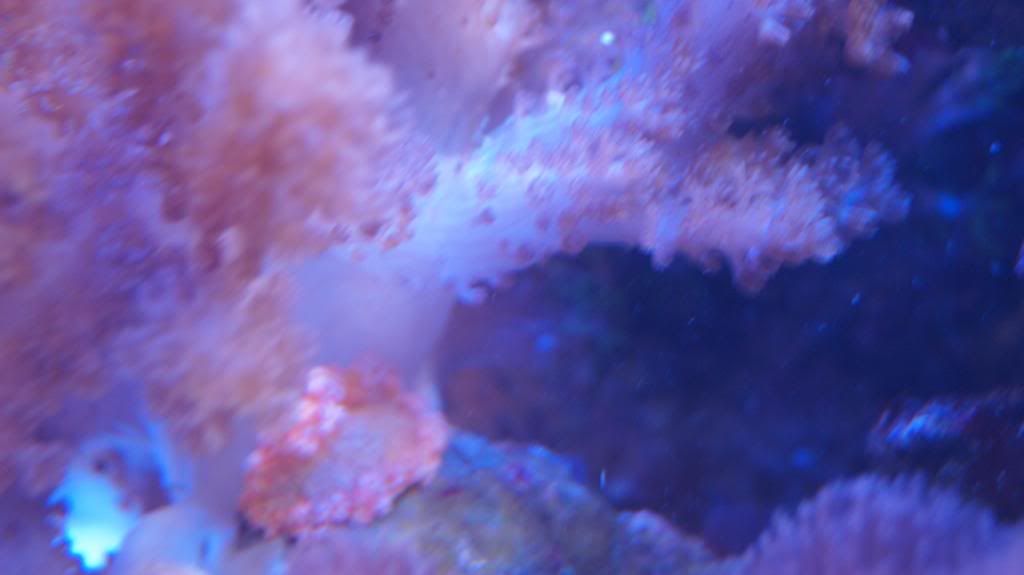 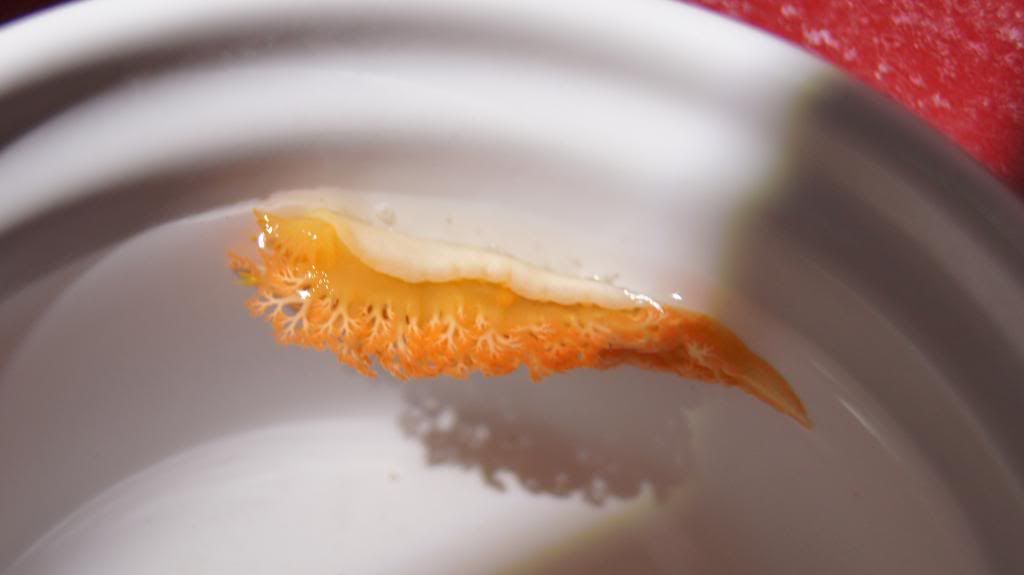 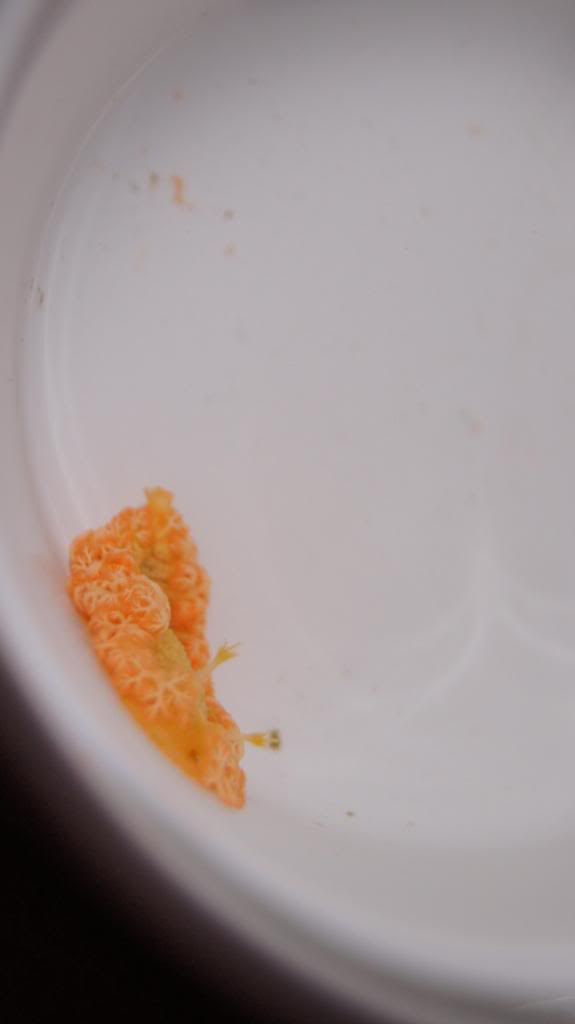 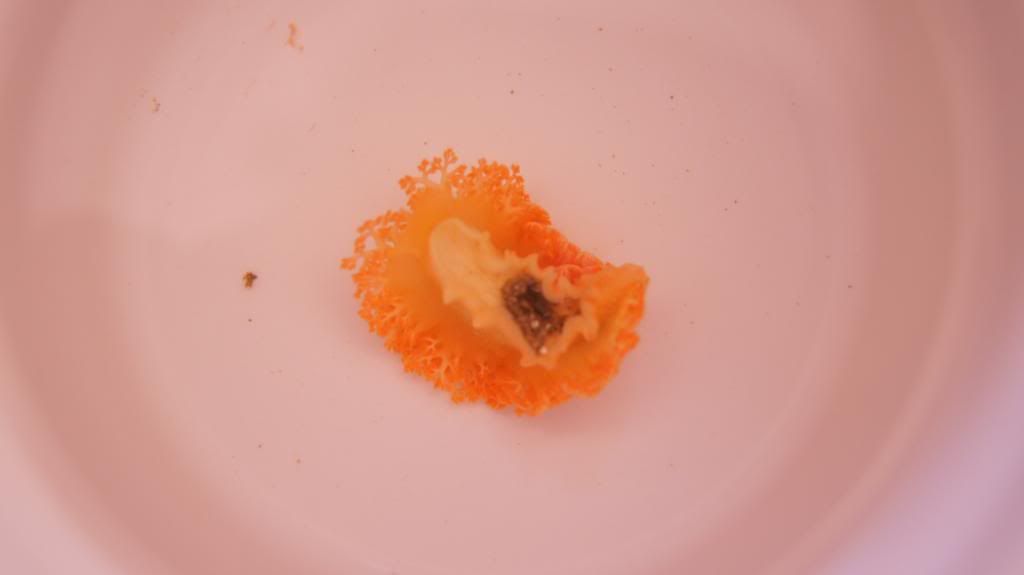 Gorgeous: 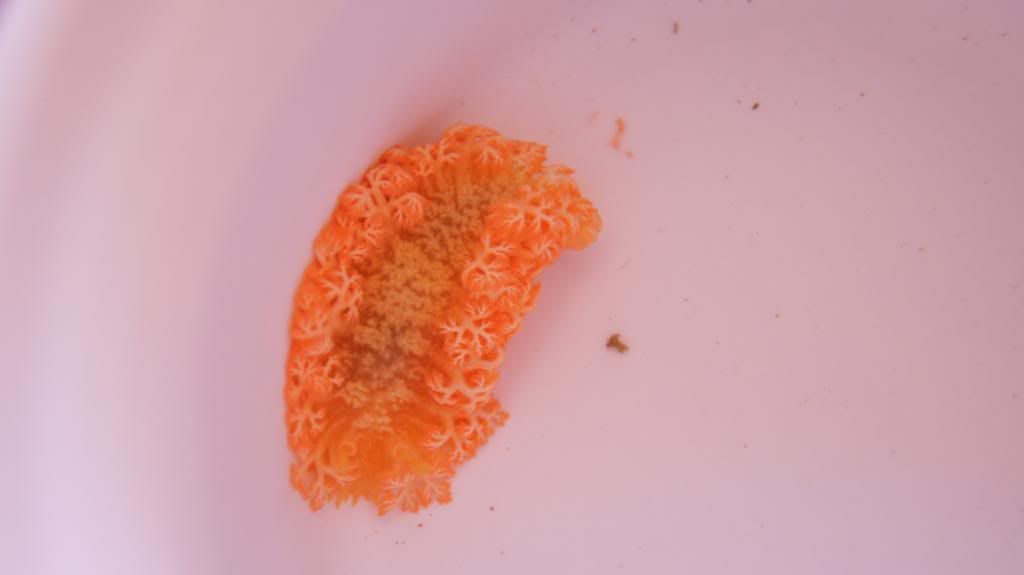 So my questions: What should I do with it? Keep it for now? (it is in the sump with an air barrier stopping it getting out of container.) Is it the species mentioned above? Have I found a new species? (  ) )If the species came on the coral, which is too likely as it is a negligible chance they just so happened to meet in my tank, then it is clear it was collected in tropical waters, of which the coral was also removed. Which however does not correspond to the scientifically noted distribution of this species. Thoughts please!!! Thanks  . .
|
|
|

|
|
|
#2 |
|
Registered Member
 Join Date: Feb 2003
Location: Northern VA
Posts: 17,691
|
It does look like tritonia nudibranchs prey on Alcyonicum soft corals, so it'll have to go.
__________________
Adrienne The only thing to fear is fear itself....and spiders. |
|
|

|
|
|
#3 |
|
Registered Member
Join Date: Apr 2010
Location: Ohio
Posts: 6,912
|
Looks gorgeous, but bad for coral.
__________________
Anything I post is just an opinion. One of many in this hobby. Believe and follow at your own risk of rapid and complete annihilation of all life in your tank :) Current Tank Info: Incept 3/2010, 150 RR, 50g sump, 20g fuge, 150w 15K MH x3, T5 actinics x8, moonlight LED x6, 1400gph return, Koralia 1400 x4, 300 g skimmer, 4 tangs, 2 mandarins, 2 perc, 6 line, 3 cardinals, 2 firefish, SPS, LPS, zoas, palys, shrooms, clam |
|
|

|
|
|
#4 |
|
Registered Member
Join Date: May 2012
Posts: 100
|
It's pretty clear it's food source is alcyonium, however there seems to be no visual ill-effect of its presence, we have had the coral for about 6-7 months. I wonder if it is worth leaving such a beautiful creature in until it starts to show negative effects? It certainly doesn't eat much. Perhaps I need to know the feeding habits of these. That's something more for me to look into, unless anyone knows already?
Oh no, I've been disillusioned by its beauty :/ |
|
|

|
|
|
#5 | |
|
Registered Member
Join Date: Jul 2012
Posts: 52
|
Quote:
|
|
|
|

|
|
|
#6 |
|
Premium Member
 |
nudibranchs are generally obligate corallivores; they consume one particular type of coral and nothing else.
I found one of the exact same type in my tank a few weeks ago when we had to tear down & rebuild due to a burst seal, and it went straight into the sump. Unfortunately it's going to starve to death because we don't have anything for it to eat; I'm 99% sure I know which coral it came in on, and it's not the type of coral these nudis eat; it likely wandered an inch too far away from its home at the LFS and ended up on the rock housing our new leather. If I had anything I could frag to feed it, I might; they really are stunning, but DO NOT even think about keeping that in your display unless you're willing to risk losing your coral(s). Incidentally, I bought a leather years ago and discovered it was absolutely infested with tiny nudibranchs. They were small, well camouflaged, and seemed to be boring into the stalk of the leather -- almost eating it from the inside-out. They did a considerable amount of damage, reducing a very healthy-looking animal to a deflated, half-eaten ball of misery in fairly short order.
__________________
"The cure for anything is salt water: sweat, tears, or the sea." - Isak Dinesen Current Tank Info: 150g mixed reef, 30g sump/refugium, LED lighting, 100lbs LR, coral beauty, flame angel, blue & yellow tangs, gobies, damsels, 6-line wrasse, lawnmower blenny, dottyback, clown pair, rabbitfish, shrimp, crabs, CUC. |
|
|

|
|
|
#7 |
|
Registered Member
Join Date: Jul 2009
Location: Cape Coral, FL
Posts: 10,431
|
The coral you have listed as it's food source and even the nudibranch name you have ID'd it as, seem to be a North Atlantic and British Isles species. Maybe it gets into warmer water and can survive. It just seems a bit strange finding one in a tropical tank, or even in an LFS tank with tropical corals? Anybody else find that a bit strange?
__________________
The good thing about science is that it's true whether or not you believe in it. (Neil deGrasse Tyson) Visit my build thread http://www.reefcentral.com/forums/showthread.php?t=2593017 |
|
|

|
|
|
#8 | |
|
Premium Member
 Join Date: Nov 2001
Location: ainrofilac lartnec
Posts: 2,182
|
I had a nudi that, structurally, looked identical but it was a pearlescent white. Mine was found on a toadstool leather, and was eating it at the base of the stalk where it attached to the rock. It did some considerable damage before I noticed it, but as soon as I removed it, seemingly over night the coral was better.
Quote:
__________________
if you're looking for me you better check under the sea, 'cause that is where you'll find me. Current Tank Info: Waiting for a 48x36x28 rimless to arrive |
|
|
|

|
|
|
#9 |
|
Registered Member
Join Date: May 2012
Posts: 100
|
The natural distribution was my source of confusion so I've been well aware it is scientifically correct. Going to have to set some time aside to go through nudipixel I think it is called and try find a +VE ID that matches its tropical origin.
Ah decisions decisions. As was noted he hasn't really moved for the 6 months we have had the coral, or harm it in any way. He has always been on the rock surrounding it, not on the coral itself, and has grown about a 1/3 of its orginal size once noticed. At least now I know to keep an eye on it. I guess it depends on what I prefer more, the coral or the nudi. I'm going to look into the very valid area of reproduction and then have a good think about what to do. It isn't causing any immediate damage, and I don't want to throw something out, only to find out a reason to possibly keep it. I'll post back any findings I get. |
|
|

|
|
|
#10 | |
|
Registered Member
Join Date: Aug 2008
Location: Jersey Shore
Posts: 3,003
|
Quote:
__________________
One Life One Shot Current Tank Info: 40B Mixed reef |
|
|
|

|
|
|
#11 |
|
Registered Member
Join Date: Mar 2008
Location: Alberta, Canada
Posts: 246
|
I guess I'm on the opposite side of the spectrum. Nudibranchs usually are very specific with their diet so you are likely only risking one type of coral, not your entire reef. You've also said that you suspect it's been in the tank for 6 months and no visible damage so far. Personally, I would keep it in the tank where you found it and roll the dice! It is a beautiful specimen so enjoy it while you can as I suspect they don't have the longest lifespan. One of the things I enjoy most with my tank is the various hitchhikers that have come with my live rock. Sure I have had to remove a couple of xanthid crabs, but everything else has been great including pistol shrimp, mushrooms, palys, Kenya tree, etc. people seem quick to cook their rock and/or flush anything that came on it.
|
|
|

|
|
|
#12 |
|
Super Best Friends!
Join Date: Jan 2008
Location: OKC, OK
Posts: 3,772
|
Maybe frag the suspected food source and put the nudi and the frag in another tank/the sump and see what happens. Wait for the frag to heal as to avoid any possible misID of the cause of death of the coral. If it eats the coral, you have an answer. If it doesn't you have a POSSIBLY safe nudi...or it's been eating another coral. If it does eat something in your tank, maybe it will grow fast enough to feed one nudi in a species tank. I would investigate before tossing it back into the main reef, but I'd also consider a way to keep it if possible.
__________________
"The moral is the chosen, not the forced; the understood, not the obeyed. The moral is the rational, and reason accepts no commandments." - John Galt Current Tank Info: Cadlights 60G Arisan II mixed reef with 2x MP40s and 24" ATI |
|
|

|
|
|
#13 |
|
Registered Member
Join Date: May 2011
Location: New Orleans, La
Posts: 1,919
|
Buy a whole bunch of frags of GSP, Xenia, clove polyps, mushrooms, and other things some people end up regretting putting in their tanks. Stick them in the sump with the nudi and see if he eats them. If you end up with a xenia munching nudi that you can get to reproduce you will have a moneymaker on your hands.
That's what I'd do.
__________________
Steve - Retired from reefing, for now. |
|
|

|
|
|
#14 |
|
Registered Member
Join Date: May 2012
Posts: 100
|
He did have to go in the end. It wasn't sustainable to keep him in the sump, as he would have to hunt his food source as the coral won't anchor immediately and there's quite a strong flow through the sump.
We put him back where he was, he had a little nibble at some bits, finished it, then when I next notcied, he had vacated and moved to the main stalk, which I can't have being eaten. Apologies if I seemed ignorant of your advice, but I do think we are sometimes too hasty to throw some things away. So I took him out an euthanised him. Found that strong Gin. did the job. I've read it is the best way, using alcohol that is, causing instant paralysis and death. |
|
|

|
|
|
#15 |
|
Registered Member
Join Date: Mar 2008
Location: Alberta, Canada
Posts: 246
|
I'm glad you got to enjoy him/her/it a little longer :-)
|
|
|

|
 |
|
|